![]()
![]()
![]()
Use LEFT and RIGHT arrow keys to navigate between flashcards;
Use UP and DOWN arrow keys to flip the card;
H to show hint;
A reads text to speech;
22 Cards in this Set
- Front
- Back
|
name and identify the muscles forming the posterior abdominal wall
|
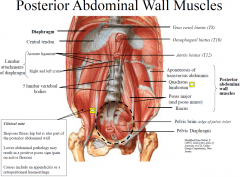
• The principal muscles of the posterior abdominal wall are the aponeurosis of transversus abdominis,
quadratus lumborum, iliacus and psoas (major & minor). |
|
|
name the major branches of the abdominal aorta
|
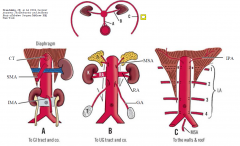
A. Unpaired brs to viscera (supply GIT): coeliac trunk, superior mesenteric a., inferior mesenteric a.
B. Paired brs to viscera: middle suprarenal, renal, gonadal (ovarian/ testicular) C. Brs to body wall: inferior phrenic, lumbar brs (4 pairs), median sacral (unpaired) |
|
|
the collateral circulation between the IVC and SVC and the effects of a blockage of either
|
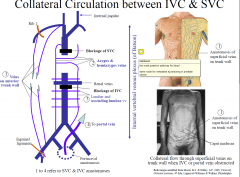
1. Anastomosis of superficial veins on trunk wall
2. Azygos & hemiazygos 3. Lumbar and ascending lumbar vv 4. Portal vein |
|
|
Posterior abdominal wall cf to anterior
|
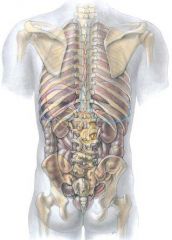
Posterior abdominal wall
- less extensive than anterior wall - more protected by bone |
|
|
Paravertebral Gutters
|
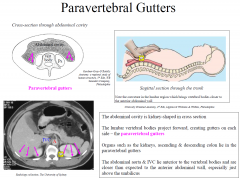
The abdominal cavity is kidney-shaped in cross section
The lumbar vertebral bodies project forward, creating gutters on each side – the paravertebral gutters Organs such as the kidneys, ascending & descending colon lie in the paravertebral gutters The abdominal aorta & IVC lie anterior to the vertebral bodies and are closer than expected to the anterior abdominal wall, especially just above the umbilicus |
|
|
Clinically Psoas Sign
|
Iliopsoas flexes hip but is also part of the posterior abdominal wall
Lower abdominal pathology may result in a positive psoas sign (pain on active flexion) Causes include an appendicitis or a retroperitoneal haemorrhage |
|
|
Major Tribuitaries of IVC
|
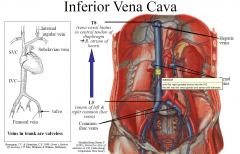
Inferior Vena Cava lies to the right side of abdominal aorta
Major tributaries are the hepatic veins, the renal veins, the suprarenal veins, the lumbar veins and the gonadal veins |
|
|
Abdominal Aorta
- AAA |
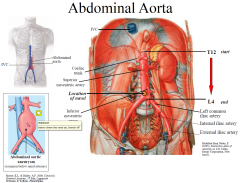
• The abdominal aorta starts at T12 and ends at L4.
|
|
|
Lymph Nodes
|
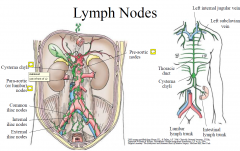
Unpaired viscera (GI tract) drain preaortic nodes
Other structures below diaphragm drain para-aortic nodes (lower limbs, pelvis, posterior abdominal wall, paired viscera) Pre and para-aortic nodes drain to cysterna chyli forms thoracic duct Thoracic duct drains to junction of left subclavian & left internal jugular veins |
|
|
Pre- arotic
|
infront of aorta
- thus recieve lymph from the GI tract because the blood to the guts comes from here |
|
|
Virchows Node
|
Virchow’s node
Left supraclavicular lymph node near termination of thoracic duct Part of the deep cervical nodes Enlargement may be a signal of lymph spread of a tumour from the area of drainage of the thoracic duct For example, may indicate cancer of lung, stomach, intestine, testis |
|
|
Lymphatic Drainage of the Body
|
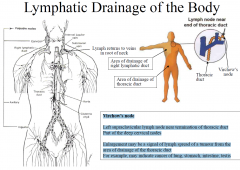
|
|
|
Nerves of posterior Abdominal Wall
|
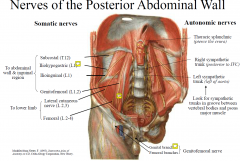
Somatic nerves to the abdominal wall and inguinal region include the subcostal, iliohypogastric, ilioinguinal
and genitofemoral nerves. |
|
|
Autonomic Nerves
|
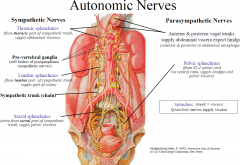
• Sympathetic autonomic nerves are the thoracic, lumbar and sacral splanchnics.
• Para-sympathetic autonomic nerves are the vagal trunks and the pelvic splanchnics. |
|
|
IVC starts at
|
• The IVC lies to the right of the aorta and starts at L5 and ends at T8.
|
|
|
Retroperitoneal Structures
|
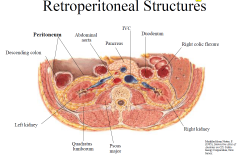
Retroperitoneal structures (structures posterior to peritoneum) include:
suprarenal glands, kidneys, ureters, pancreas (except tail), duodenum (except first few cms), ascending & descending colon, abdominal aorta, IVC & all associated lymph nodes and autonomic nerves |
|
|
Clinical Significance
|
clincal significance; T12-L1, thus can get back pain from inflammation of these structures irritating the somatic nerves
|
|
|
Retroperitoneal Structures
|
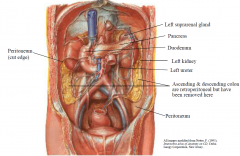
|
|
|
Suprarenal Glands:
aa vv nn |
Arterial supply: superior, middle and inferior suprarenal (branches of inferior phrenic, abdominal aorta & renal arteries, respectively)
Venous drainage: right suprarenal gland drains to IVC, left suprarenal gland drains to left renal vein Innervation: preganglionic sympathetic nerves from the thoracic splanchnic nerves synapse directly on chromaffin cells of adrenal medulla (not via postganglionic neurons). Cells release adrenaline & noradrenaline directly into the circulation via suprarenal veins |
|
|
Suprarenal Glands
|
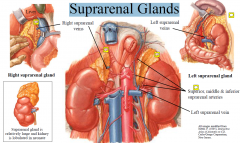
|
|
|
Suprarenal Glands Innervation
|

|
|
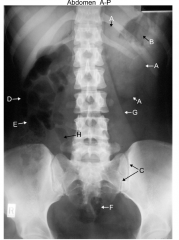
|
A. renal outline, B. gas in fundus of stomach, C. sacroiliac joint, D. gas in ascending colon, E. faeces in
ascending colon, F. gas in rectum or sigmoid colon, G. lateral border of psoas major, H. gas in transverse colon |

